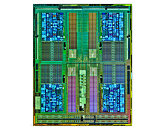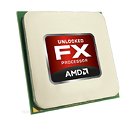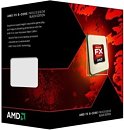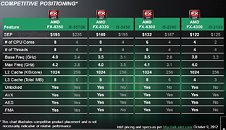Monday, October 22nd 2012

AMD Announces 2012 FX "Vishera" Line of Performance Desktop Processors
AMD announced the 2012 FX "Vishera" line of eight-core, six-core, and quad-core desktop processors. Based on the new "Piledriver" CPU micro-architecture, the new processors feature increased performance and an updated instruction set, over the previous generation. To begin with, the processors are based around the "Vishera" silicon, built on the 32 nm HKMG process at Global Foundries. With a transistor count of 1.2 billion and a die area of 315 mm², Vishera packs four Piledriver modules, with two cores each, 2 MB L2 cache per module (8 MB total), and 8 MB of L3 cache. Eight-, six-, and four-core models are carved out by toggling the number of modules between four, three, and two.
The Vishera silicon also features an updated CPU instruction set, which includes SSE/2/3/S3/4.1/4.2/4A, AVX, AES-NI, FMA/FMA2/FMA3, XOP, and F16C. An x86 processor by design, Vishera features the AMD64 x86-64 instruction set. Its updated integrated memory controller supports up to 64 GB of dual-channel DDR3 memory, with a standard speed of DDR3-1866 MHz, and more possible with overclocking. The memory interface is single, monolithic 128-bit, unlike the dual 64-bit IMC approach of the "Stars" micro-architecture. Built in the same socket AM3+ package as the previous generation FX, the new chips are compatible with existing AM3+ motherboards with a BIOS update. The 2012 FX processor lineup includes a total of four models, the FX-8350 flagship eight-core, FX-8320 performance eight-core, FX-6300 mainstream six-core, and FX-4300 value quad-core. All models feature unlocked base-clock multipliers, making each of them fit for overclocking. Their specifications and target SEP pricing are tabled below. Market prices could be about 5~10% above the SEP prices.
The Vishera silicon also features an updated CPU instruction set, which includes SSE/2/3/S3/4.1/4.2/4A, AVX, AES-NI, FMA/FMA2/FMA3, XOP, and F16C. An x86 processor by design, Vishera features the AMD64 x86-64 instruction set. Its updated integrated memory controller supports up to 64 GB of dual-channel DDR3 memory, with a standard speed of DDR3-1866 MHz, and more possible with overclocking. The memory interface is single, monolithic 128-bit, unlike the dual 64-bit IMC approach of the "Stars" micro-architecture. Built in the same socket AM3+ package as the previous generation FX, the new chips are compatible with existing AM3+ motherboards with a BIOS update. The 2012 FX processor lineup includes a total of four models, the FX-8350 flagship eight-core, FX-8320 performance eight-core, FX-6300 mainstream six-core, and FX-4300 value quad-core. All models feature unlocked base-clock multipliers, making each of them fit for overclocking. Their specifications and target SEP pricing are tabled below. Market prices could be about 5~10% above the SEP prices.




40 Comments on AMD Announces 2012 FX "Vishera" Line of Performance Desktop Processors
The trend will continue till the new consoles come out.
Even if your statement is true (absolutely unlikely), Vishera can handle all non-multicore games just fine as its current clockspeed (even a Phenom II can do so).
Funny fact: All Capcom (a huge console game publisher) games in the past three years support multi-threads.
It's because the market for PC games is not big enough for publishers to make the investment (think about the people who have i7 and GTXs).
Prettier a game, more expensive it is to make. I'm pretty sure all the devs out there want as much money as possible to make the prettiest evar but they just don't get funded that way.
And, I just love to argue.
While not exactly as low as the lower voltage/lower wattage/smaller die intel chips it is still a vast improvement over the previous generation.
Think I might just pick one of these up. Maybe be my last AMD CPU if things don't improve. Now to just wait for a good deal. Sorry Newegg but $220 is too much. Gimmie that $200 price point or give me a special bundle game deal and then I'll bite.
According to TPU, it consumes 254W when O'ced. Now compare it to the stock 134W. It's almost twice the power consumption. At least to me, it's unacceptable.
he clearly said:and there's this:
i7 3770K overclocks from 3.5GHz to 4.6GHz, which is 31% overclock. It consumes only 39.3% more power, when load. (www.anandtech.com/show/5771/the-intel-ivy-bridge-core-i7-3770k-review/4)
FX-8350 overclocks from 4GHz to 4.8GHz, which is only 20% overclock. It consumes hefty 59% more power, when load. (www.anandtech.com/show/6396/the-vishera-review-amd-fx8350-fx8320-fx6300-and-fx4300-tested/8)
According to that 8350 review, i7 3770K at 4.6GHz would have been used only 167W, which will be lower than that of FX-8350's stock power consumption
I didn't try to bash you. But I always respect the reality rather than speculations. If you really need to compare a lower tier of product to higher tier. Try to compare it with the best or at least second best. Then compare the performance gained percentage with power consumption percentage. For example try to compare FX8350 @4.8GHz against i7 3930K @ stock, because i7 3970K(@stock clock) will prevail Fully O'ced FX. Now compare the power consumption of stock i7 3930K and FX's (@4.8GHz) power consumption. Otherwise compare it with i7 3770K or i5 3570K (Both FX and Ivy fully overclocked). Still ivybridge overclocks better than FX-8350 (Ivy bridge's 31% OC vs 8350's 20% OC) on air cooler :shadedshu
We as the PC community want to move forward, are limited in graphics technology from earlier consoles.
There are a few gleaming examples though, like dishonored, that shine through, but they are few and far between.
i think you missed the point...
perhaps you should at least read on wikipedia first..
Too bad here in Lithuania computer parts usually "lag behind" by at least a week. (The bulldozer "lagged" by more than a month, for example). That's a long time to deal with this mouth watering. As 'dose Piledrivers do look tasty...